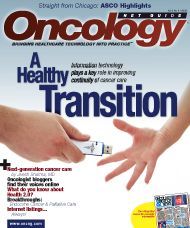Endobronchial Ultrasound: An effective tool in the diagnosis of mediastinal lymphadenopathy and lung cancer
Lately, ultrasound has been used to increase sampling accuracy. Trans-thoracic ultrasound does not provide adequate guidance because of the difficulty in imaging the mediastinum
Mediastinal nodal involvement is an important factor in non—small cell lung cancer (NSCLC) staging to determine surgical resectability. Failure to identify mediastinal disease adequately may contribute to relapse, despite an apparently successful resection. However, the sensitivity and specificity of CT and PET in predicting malignant mediastinal nodal involvement are low. Accurate sampling with pathologic examination of intrathoracic nodes is the best predictor to determine prognosis and treatment
options.
Cervical mediastinoscopy has the limitation of only accessing the left and right paratracheal, precarinal, and anterior subcarinal nodes, leaving aortopulmonary window and preaortic and subaortic nodes to be explored by an anterior mediastinotomy
or the posterior and inferior nodes by thoracoscopy. Pulmonologists can obtain cytological and even histological specimens with a bronchoscopic trans-bronchial needle aspiration (TBNA). After reviewing the nodal locations on CT or PET imaging, a bronchoscope is positioned in the appropriate site, and a needle is then inserted through the tracheal or bronchial wall to sample nodes. Compared to mediastinoscopy, this is a blind technique, often resulting in a missed diagnosis.
Lately, ultrasound has been used to increase sampling accuracy. Trans-thoracic ultrasound does not provide adequate guidance because of the difficulty in imaging the mediastinum. A small ultrasound probe inserted in the airways, known as endobronchial ultrasound (EBUS), has been developed to localize nodes around the airways. At present, two types of EBUS are available: a radial probe and a linear probe. The radial probe is usually inserted through the bronchoscope for localization of nodes and is removed prior to the TBNA. So, the actual biopsy is not done under direct visualization. The advent of a dedicated bronchoscope with a linear probe attached to the tip allows nodes to be sampled under direct guidance. The bronchoscopic and ultrasound images can be monitored simultaneously, making it easier to locate the nodes. The nearby vascular structures are also identified with the color flow Doppler, minimizing any potential bleeding complications. EBUS—TBNA may be achieved with a 22G needle aspiration under direct ultrasound guidance in real-time from paratracheal, parabronchialand, or hilar lymph nodes with increased accuracy. EBUS–TBNA has an overall sensitivity of 90% and a false negative rate of 24%.2 Recent data suggests that EBUS–TBNA sampling is defi nitive in 75% of patients with benign disease.
It has 89% sensitivity of detecting occult malignancy in clinical stage1 lung cancer with <1cm diameter nodes, suggesting that potentially operable patients with no signs of mediastinal involvement on CT or PET may benefit from presurgical staging with EBUS-TBNA.4 EBUS-TBNA is a less invasive way to reliably sample mediastinal lymph nodes in patients who may have respiratory insuffi ciency from emphysema or radiation fi brosis or who are too weak from previous chemotherapy to tolerate an invasive surgical procedure. EBUS-TBNA may also assist during follow-up of NSCLC patients with concurrent lymphadenopathy from sarcoidosis or granulomatous diseases, another diagnostic dilemma frequently faced by the oncologists. EBUS-TBNA is becoming a valuable tool in the algorithm of lung cancer detection. It is safe, reliable, and cost-effective, with minimal complications.
Dr. Islam is an assistant professor and director of interventional pulmonary medicine in the Division of Pulmonary, Allergy, Critical Care and Sleep Medicine at the Ohio State University Medical Center.
